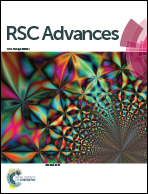Synthesis of tailor-made bile acid sequestrants by supplemental activator and reducing agent atom transfer radical polymerization†
Abstract
This work reports the synthesis of tailor-made polymeric bile acid sequestrants (BAS) by supplemental activator and reducing agent atom transfer radical polymerization (SARA ATRP) using ecofriendly conditions. The new materials were based on amphiphilic poly(methyl acrylate)-b-poly((3-acrylamidopropyl)trimethylammonium chloride) (PMA-b-PAMPTMA) star block copolymers and cationic hydrogels (PAMPTMA). The in vitro sequestration ability of the polymers was investigated in simulated intestinal fluid using sodium cholate (NaCA) as the bile salt model molecule. Both polymeric structures investigated showed higher affinity towards NaCA micelles than unimers. The cationic hydrogels proved to be attractive BAS candidates, with binding parameters similar to those of the most effective commercial BAS: Colesevelam hydrochloride. Several polymer features were investigated for the star block copolymers in order to understand the structure/performance relationship. It was found that the binding parameters can be tuned by targeting different compositions of the block copolymers and, typically, longer cationic arms led to enhanced binding capacity.



 Please wait while we load your content...
Please wait while we load your content...